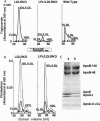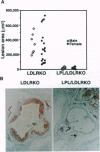Abstract
Lipoprotein lipase (LPL) is a key enzyme in the hydrolysis of triglyceride-rich lipoproteins. Conflicting results have been reported concerning its role in atherogenesis. To determine the effects of the overexpressed LPL on diet-induced atherosclerosis, we have generated low density lipoprotein receptor (LDLR) knockout mice that overexpressed human LPL transgene (LPL/LDLRKO) and compared their plasma lipoproteins and atherosclerosis with those in nonexpressing LDLR-knockout mice (LDLRKO). On a normal chow diet, LPL/LDLRKO mice showed marked suppression of mean plasma triglyceride levels (32 versus 236 mg/dl) and modest decrease in mean cholesterol levels (300 versus 386 mg/dl) as compared with LDLRKO mice. Larger lipoprotein particles of intermediate density lipoprotein (IDL)/LDL were selectively reduced in LPL/LDLRKO mice. On an atherogenic diet, both mice exhibited severe hypercholesterolemia. But, mean plasma cholesterol levels in LPL/ LDLRKO mice were still suppressed as compared with that in LDLRKO mice (1357 versus 2187 mg/dl). Marked reduction in a larger subfraction of IDL/LDL, which conceivably corresponds to remnant lipoproteins, was observed in the LPL/LDLRKO mice. LDLRKO mice developed severe fatty streak lesions in the aortic sinus after feeding with the atherogenic diet for 8 weeks. In contrast, mean lesion area in the LPL/LDLRKO mice was 18-fold smaller than that in LDLRKO mice. We suggest that the altered lipoprotein profile, in particular the reduced level of remnant lipoproteins, is mainly responsible for the protection by LPL against atherosclerosis.
Full text
PDF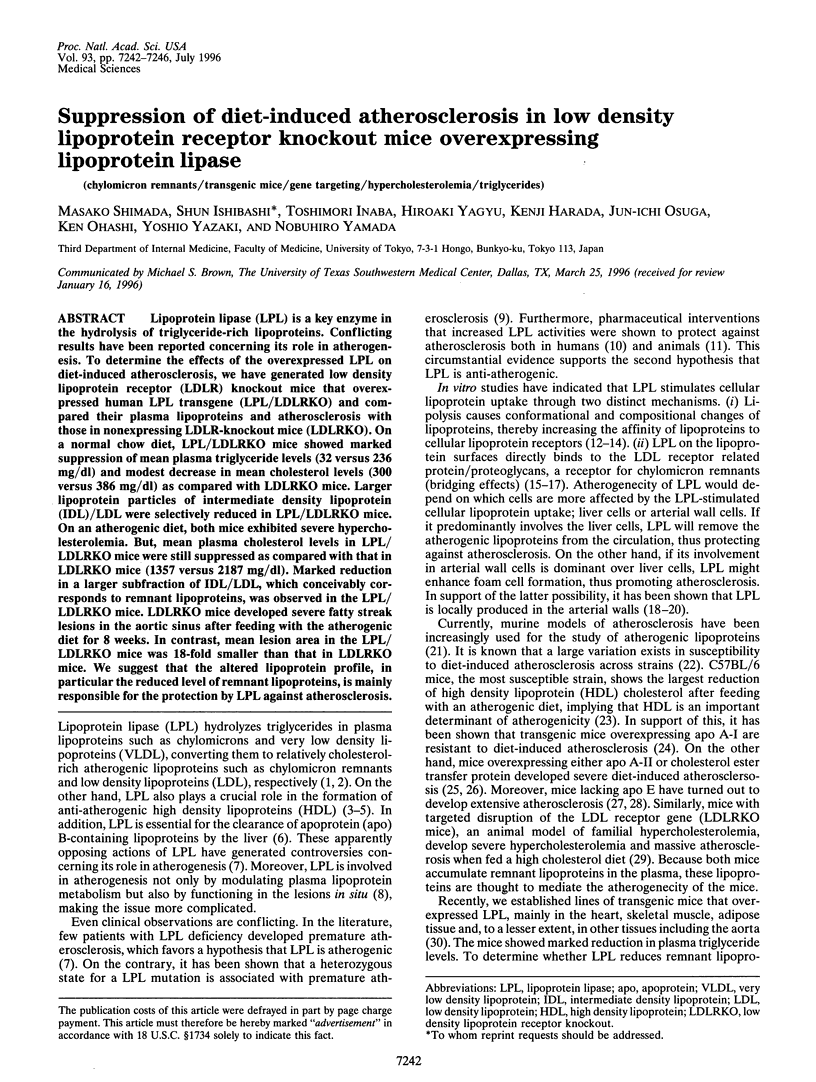
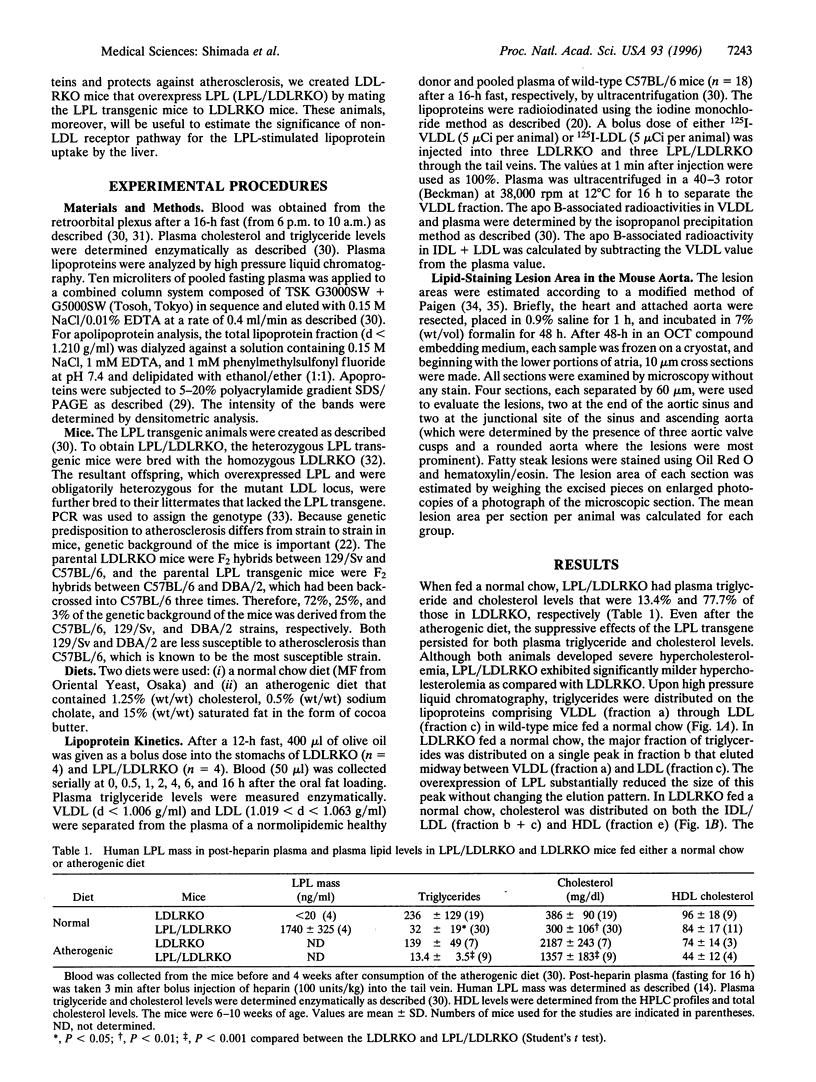
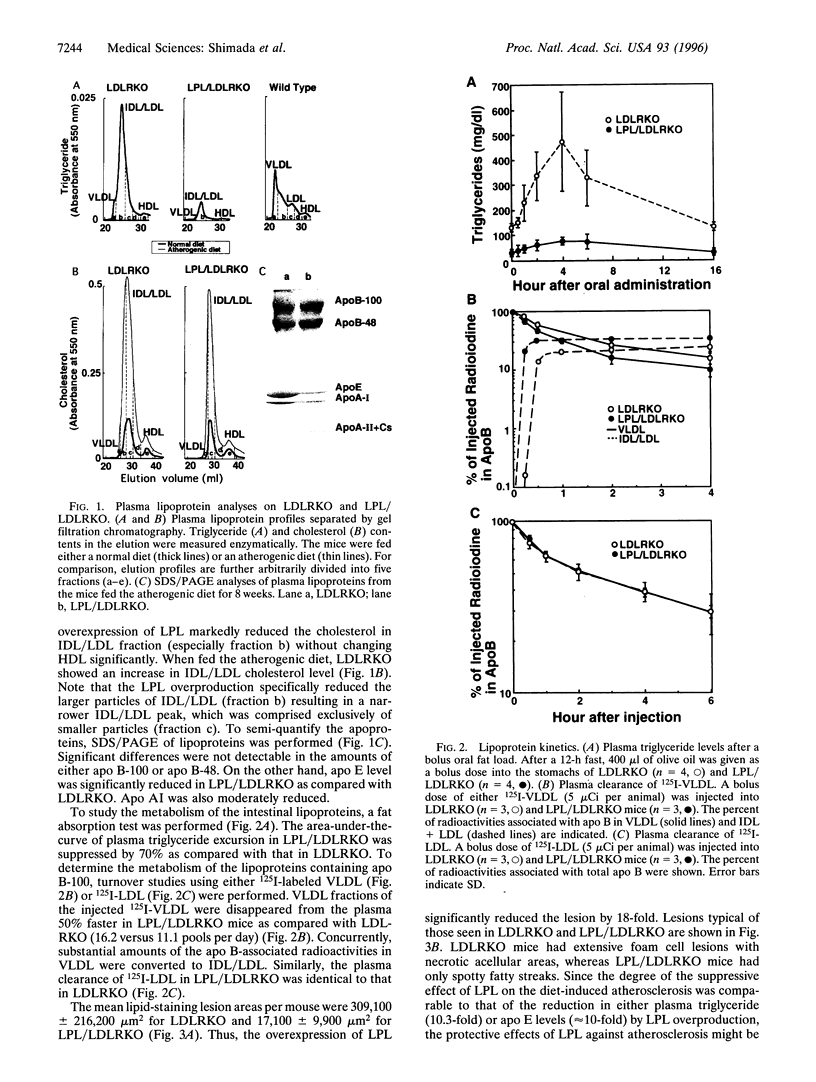
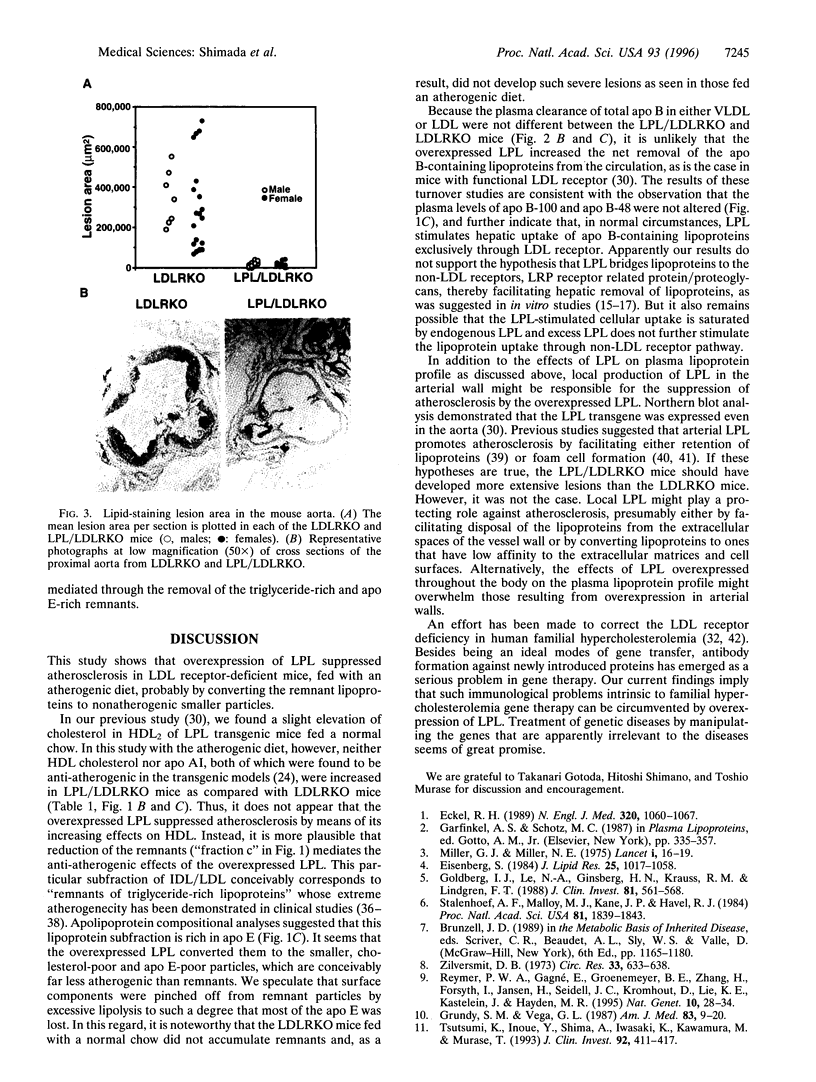
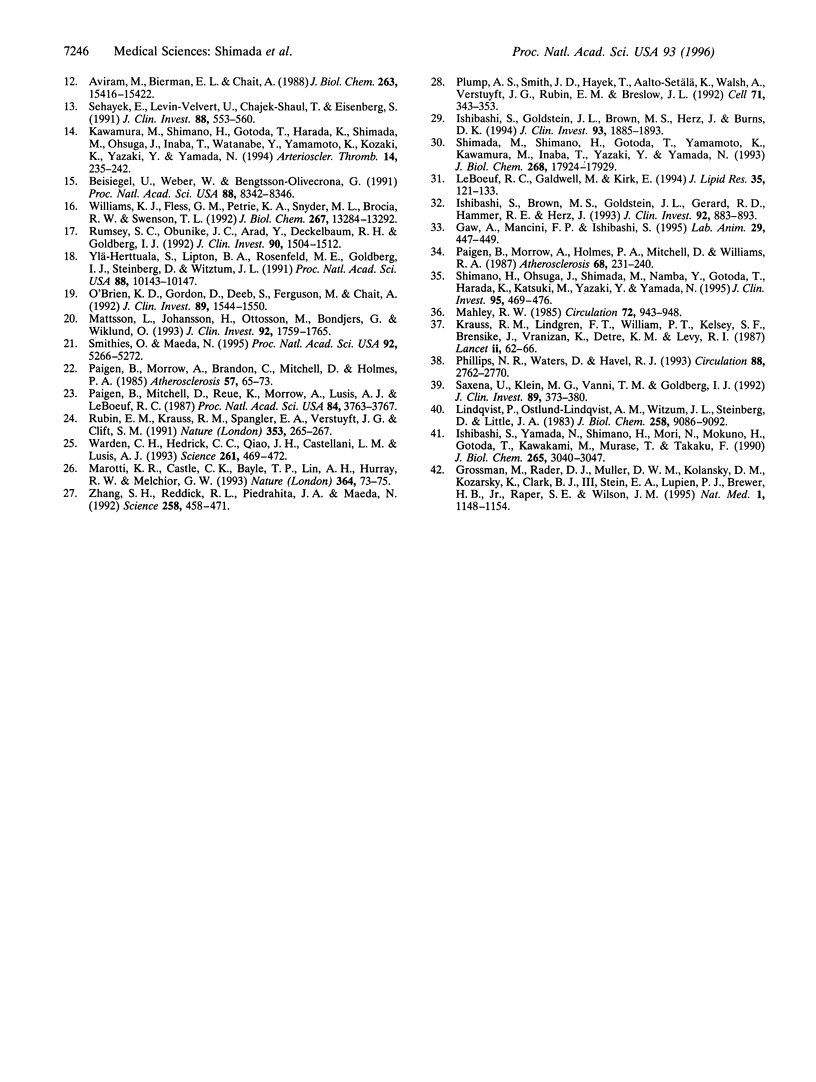
Images in this article
Selected References
These references are in PubMed. This may not be the complete list of references from this article.
- Aviram M., Bierman E. L., Chait A. Modification of low density lipoprotein by lipoprotein lipase or hepatic lipase induces enhanced uptake and cholesterol accumulation in cells. J Biol Chem. 1988 Oct 25;263(30):15416–15422. [PubMed] [Google Scholar]
- Beisiegel U., Weber W., Bengtsson-Olivecrona G. Lipoprotein lipase enhances the binding of chylomicrons to low density lipoprotein receptor-related protein. Proc Natl Acad Sci U S A. 1991 Oct 1;88(19):8342–8346. doi: 10.1073/pnas.88.19.8342. [DOI] [PMC free article] [PubMed] [Google Scholar]
- Eckel R. H. Lipoprotein lipase. A multifunctional enzyme relevant to common metabolic diseases. N Engl J Med. 1989 Apr 20;320(16):1060–1068. doi: 10.1056/NEJM198904203201607. [DOI] [PubMed] [Google Scholar]
- Eisenberg S. High density lipoprotein metabolism. J Lipid Res. 1984 Oct;25(10):1017–1058. [PubMed] [Google Scholar]
- Gaw A., Mancini F. P., Ishibashi S. Rapid genotyping of low density lipoprotein receptor knockout mice using a polymerase chain reaction technique. Lab Anim. 1995 Oct;29(4):447–449. doi: 10.1258/002367795780739944. [DOI] [PubMed] [Google Scholar]
- Goldberg I. J., Le N. A., Ginsberg H. N., Krauss R. M., Lindgren F. T. Lipoprotein metabolism during acute inhibition of lipoprotein lipase in the cynomolgus monkey. J Clin Invest. 1988 Feb;81(2):561–568. doi: 10.1172/JCI113354. [DOI] [PMC free article] [PubMed] [Google Scholar]
- Grossman M., Rader D. J., Muller D. W., Kolansky D. M., Kozarsky K., Clark B. J., 3rd, Stein E. A., Lupien P. J., Brewer H. B., Jr, Raper S. E. A pilot study of ex vivo gene therapy for homozygous familial hypercholesterolaemia. Nat Med. 1995 Nov;1(11):1148–1154. doi: 10.1038/nm1195-1148. [DOI] [PubMed] [Google Scholar]
- Grundy S. M., Vega G. L. Fibric acids: effects on lipids and lipoprotein metabolism. Am J Med. 1987 Nov 27;83(5B):9–20. doi: 10.1016/0002-9343(87)90866-7. [DOI] [PubMed] [Google Scholar]
- Ishibashi S., Brown M. S., Goldstein J. L., Gerard R. D., Hammer R. E., Herz J. Hypercholesterolemia in low density lipoprotein receptor knockout mice and its reversal by adenovirus-mediated gene delivery. J Clin Invest. 1993 Aug;92(2):883–893. doi: 10.1172/JCI116663. [DOI] [PMC free article] [PubMed] [Google Scholar]
- Ishibashi S., Goldstein J. L., Brown M. S., Herz J., Burns D. K. Massive xanthomatosis and atherosclerosis in cholesterol-fed low density lipoprotein receptor-negative mice. J Clin Invest. 1994 May;93(5):1885–1893. doi: 10.1172/JCI117179. [DOI] [PMC free article] [PubMed] [Google Scholar]
- Ishibashi S., Yamada N., Shimano H., Mori N., Mokuno H., Gotohda T., Kawakami M., Murase T., Takaku F. Apolipoprotein E and lipoprotein lipase secreted from human monocyte-derived macrophages modulate very low density lipoprotein uptake. J Biol Chem. 1990 Feb 25;265(6):3040–3047. [PubMed] [Google Scholar]
- Kawamura M., Shimano H., Gotoda T., Harada K., Shimada M., Ohsuga J., Inaba T., Watanabe Y., Yamamoto K., Kozaki K. Overexpression of human lipoprotein lipase enhances uptake of lipoproteins containing apolipoprotein B-100 in transfected cells. Arterioscler Thromb. 1994 Feb;14(2):235–242. doi: 10.1161/01.atv.14.2.235. [DOI] [PubMed] [Google Scholar]
- Krauss R. M., Lindgren F. T., Williams P. T., Kelsey S. F., Brensike J., Vranizan K., Detre K. M., Levy R. I. Intermediate-density lipoproteins and progression of coronary artery disease in hypercholesterolaemic men. Lancet. 1987 Jul 11;2(8550):62–66. doi: 10.1016/s0140-6736(87)92734-6. [DOI] [PubMed] [Google Scholar]
- LeBoeuf R. C., Caldwell M., Kirk E. Regulation by nutritional status of lipids and apolipoproteins A-I, A-II, and A-IV in inbred mice. J Lipid Res. 1994 Jan;35(1):121–133. [PubMed] [Google Scholar]
- Lindqvist P., Ostlund-Lindqvist A. M., Witztum J. L., Steinberg D., Little J. A. The role of lipoprotein lipase in the metabolism of triglyceride-rich lipoproteins by macrophages. J Biol Chem. 1983 Aug 10;258(15):9086–9092. [PubMed] [Google Scholar]
- Mahley R. W. Atherogenic lipoproteins and coronary artery disease: concepts derived from recent advances in cellular and molecular biology. Circulation. 1985 Nov;72(5):943–948. doi: 10.1161/01.cir.72.5.943. [DOI] [PubMed] [Google Scholar]
- Marotti K. R., Castle C. K., Boyle T. P., Lin A. H., Murray R. W., Melchior G. W. Severe atherosclerosis in transgenic mice expressing simian cholesteryl ester transfer protein. Nature. 1993 Jul 1;364(6432):73–75. doi: 10.1038/364073a0. [DOI] [PubMed] [Google Scholar]
- Mattsson L., Johansson H., Ottosson M., Bondjers G., Wiklund O. Expression of lipoprotein lipase mRNA and secretion in macrophages isolated from human atherosclerotic aorta. J Clin Invest. 1993 Oct;92(4):1759–1765. doi: 10.1172/JCI116764. [DOI] [PMC free article] [PubMed] [Google Scholar]
- Miller K. L. Post delivery care of the edentulous geriatric patient. Bull Phila Cty Dent Soc. 1975 Summer;40(8):16–19. [PubMed] [Google Scholar]
- O'Brien K. D., Gordon D., Deeb S., Ferguson M., Chait A. Lipoprotein lipase is synthesized by macrophage-derived foam cells in human coronary atherosclerotic plaques. J Clin Invest. 1992 May;89(5):1544–1550. doi: 10.1172/JCI115747. [DOI] [PMC free article] [PubMed] [Google Scholar]
- Paigen B., Mitchell D., Reue K., Morrow A., Lusis A. J., LeBoeuf R. C. Ath-1, a gene determining atherosclerosis susceptibility and high density lipoprotein levels in mice. Proc Natl Acad Sci U S A. 1987 Jun;84(11):3763–3767. doi: 10.1073/pnas.84.11.3763. [DOI] [PMC free article] [PubMed] [Google Scholar]
- Paigen B., Morrow A., Brandon C., Mitchell D., Holmes P. Variation in susceptibility to atherosclerosis among inbred strains of mice. Atherosclerosis. 1985 Oct;57(1):65–73. doi: 10.1016/0021-9150(85)90138-8. [DOI] [PubMed] [Google Scholar]
- Paigen B., Morrow A., Holmes P. A., Mitchell D., Williams R. A. Quantitative assessment of atherosclerotic lesions in mice. Atherosclerosis. 1987 Dec;68(3):231–240. doi: 10.1016/0021-9150(87)90202-4. [DOI] [PubMed] [Google Scholar]
- Phillips N. R., Waters D., Havel R. J. Plasma lipoproteins and progression of coronary artery disease evaluated by angiography and clinical events. Circulation. 1993 Dec;88(6):2762–2770. doi: 10.1161/01.cir.88.6.2762. [DOI] [PubMed] [Google Scholar]
- Plump A. S., Smith J. D., Hayek T., Aalto-Setälä K., Walsh A., Verstuyft J. G., Rubin E. M., Breslow J. L. Severe hypercholesterolemia and atherosclerosis in apolipoprotein E-deficient mice created by homologous recombination in ES cells. Cell. 1992 Oct 16;71(2):343–353. doi: 10.1016/0092-8674(92)90362-g. [DOI] [PubMed] [Google Scholar]
- Reymer P. W., Gagné E., Groenemeyer B. E., Zhang H., Forsyth I., Jansen H., Seidell J. C., Kromhout D., Lie K. E., Kastelein J. A lipoprotein lipase mutation (Asn291Ser) is associated with reduced HDL cholesterol levels in premature atherosclerosis. Nat Genet. 1995 May;10(1):28–34. doi: 10.1038/ng0595-28. [DOI] [PubMed] [Google Scholar]
- Rubin E. M., Krauss R. M., Spangler E. A., Verstuyft J. G., Clift S. M. Inhibition of early atherogenesis in transgenic mice by human apolipoprotein AI. Nature. 1991 Sep 19;353(6341):265–267. doi: 10.1038/353265a0. [DOI] [PubMed] [Google Scholar]
- Rumsey S. C., Obunike J. C., Arad Y., Deckelbaum R. J., Goldberg I. J. Lipoprotein lipase-mediated uptake and degradation of low density lipoproteins by fibroblasts and macrophages. J Clin Invest. 1992 Oct;90(4):1504–1512. doi: 10.1172/JCI116018. [DOI] [PMC free article] [PubMed] [Google Scholar]
- Saxena U., Klein M. G., Vanni T. M., Goldberg I. J. Lipoprotein lipase increases low density lipoprotein retention by subendothelial cell matrix. J Clin Invest. 1992 Feb;89(2):373–380. doi: 10.1172/JCI115595. [DOI] [PMC free article] [PubMed] [Google Scholar]
- Sehayek E., Lewin-Velvert U., Chajek-Shaul T., Eisenberg S. Lipolysis exposes unreactive endogenous apolipoprotein E-3 in human and rat plasma very low density lipoprotein. J Clin Invest. 1991 Aug;88(2):553–560. doi: 10.1172/JCI115339. [DOI] [PMC free article] [PubMed] [Google Scholar]
- Shimada M., Shimano H., Gotoda T., Yamamoto K., Kawamura M., Inaba T., Yazaki Y., Yamada N. Overexpression of human lipoprotein lipase in transgenic mice. Resistance to diet-induced hypertriglyceridemia and hypercholesterolemia. J Biol Chem. 1993 Aug 25;268(24):17924–17929. [PubMed] [Google Scholar]
- Shimano H., Ohsuga J., Shimada M., Namba Y., Gotoda T., Harada K., Katsuki M., Yazaki Y., Yamada N. Inhibition of diet-induced atheroma formation in transgenic mice expressing apolipoprotein E in the arterial wall. J Clin Invest. 1995 Feb;95(2):469–476. doi: 10.1172/JCI117687. [DOI] [PMC free article] [PubMed] [Google Scholar]
- Smithies O., Maeda N. Gene targeting approaches to complex genetic diseases: atherosclerosis and essential hypertension. Proc Natl Acad Sci U S A. 1995 Jun 6;92(12):5266–5272. doi: 10.1073/pnas.92.12.5266. [DOI] [PMC free article] [PubMed] [Google Scholar]
- Stalenhoef A. F., Malloy M. J., Kane J. P., Havel R. J. Metabolism of apolipoproteins B-48 and B-100 of triglyceride-rich lipoproteins in normal and lipoprotein lipase-deficient humans. Proc Natl Acad Sci U S A. 1984 Mar;81(6):1839–1843. doi: 10.1073/pnas.81.6.1839. [DOI] [PMC free article] [PubMed] [Google Scholar]
- Tsutsumi K., Inoue Y., Shima A., Iwasaki K., Kawamura M., Murase T. The novel compound NO-1886 increases lipoprotein lipase activity with resulting elevation of high density lipoprotein cholesterol, and long-term administration inhibits atherogenesis in the coronary arteries of rats with experimental atherosclerosis. J Clin Invest. 1993 Jul;92(1):411–417. doi: 10.1172/JCI116582. [DOI] [PMC free article] [PubMed] [Google Scholar]
- Warden C. H., Hedrick C. C., Qiao J. H., Castellani L. W., Lusis A. J. Atherosclerosis in transgenic mice overexpressing apolipoprotein A-II. Science. 1993 Jul 23;261(5120):469–472. doi: 10.1126/science.8332912. [DOI] [PubMed] [Google Scholar]
- Williams K. J., Fless G. M., Petrie K. A., Snyder M. L., Brocia R. W., Swenson T. L. Mechanisms by which lipoprotein lipase alters cellular metabolism of lipoprotein(a), low density lipoprotein, and nascent lipoproteins. Roles for low density lipoprotein receptors and heparan sulfate proteoglycans. J Biol Chem. 1992 Jul 5;267(19):13284–13292. [PubMed] [Google Scholar]
- Ylä-Herttuala S., Lipton B. A., Rosenfeld M. E., Goldberg I. J., Steinberg D., Witztum J. L. Macrophages and smooth muscle cells express lipoprotein lipase in human and rabbit atherosclerotic lesions. Proc Natl Acad Sci U S A. 1991 Nov 15;88(22):10143–10147. doi: 10.1073/pnas.88.22.10143. [DOI] [PMC free article] [PubMed] [Google Scholar]
- Zhang S. H., Reddick R. L., Piedrahita J. A., Maeda N. Spontaneous hypercholesterolemia and arterial lesions in mice lacking apolipoprotein E. Science. 1992 Oct 16;258(5081):468–471. doi: 10.1126/science.1411543. [DOI] [PubMed] [Google Scholar]
- Zilversmit D. B. A proposal linking atherogenesis to the interaction of endothelial lipoprotein lipase with triglyceride-rich lipoproteins. Circ Res. 1973 Dec;33(6):633–638. doi: 10.1161/01.res.33.6.633. [DOI] [PubMed] [Google Scholar]



